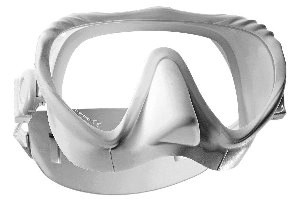Home › A-Z of Diving › Scuba Gear › Masks
Masks for Scuba Diving
Divers need a mask to see underwater because light reacts differently in water than in air and the mask creates an air space, which helps our eyes to focus.
A scuba mask is used to provide a small pocket of air between the divers' eyes and the surrounding water.
This is because our eyes don't focus clearly underwater due to the physical effects of refraction.
This air space is the reason that the mask must enclose your nose for equalization and that is why divers cannot dive with swimming goggles.
Manufacturer use tempered glass for added safety, when they make diving masks. Look for a comfortable close-fitting skirt, a nose pocket, an adjustable strap, and a wide field of vision.
Dive Goggles
Commonly called goggles, the main features of scuba masks is to enclose the nose and eyes by making a reliable and comfortable seal from the mask skirt onto the face, which can be adjusted to make a watertight fit by tightening the mask strap.
The lenses should be made from tempered glass for safety reasons and modern dive masks can be fitted with a prescription lens which benefits divers who wear glasses or contacts lenses.
New masks are usually coated with a protective lacquer which should be removed before diving by scrubbing the inside and outside of the lens as recommended by the mask manufacturer or a light abrasive white toothpaste often serves the same purpose.
Scuba Masks are available in a huge variety of colors, styles and sizes and many equipment manufacturers now also make dive masks for kids.
 A scuba mask provides an air pocket between your eyes and the water, because human eyes cannot focus clearly under water.
A scuba mask provides an air pocket between your eyes and the water, because human eyes cannot focus clearly under water.
Sometimes called a dive mask, diver's mask, goggles (slang), half mask, or face plate, the main features of a scuba mask should, enclose the nose, be made with tempered glass, and the skirt should make a comfortable and reliable seal.
Some masks can be fitted with prescription lenses, which is convenient if you wear glasses or use contacts.
Scuba Mask Tips - If you purchase a new mask, the manufacturer will probably have coated the lens with a protective lacquer. Scrub out a new mask with white toothpaste or as recommended by the manufacturer.
This removes the chemical and avoids fogging, and can be repeated before each dive, by using a defogging solution according to the manufacturers instructions.
Scuba Diving Fins |> Snorkel Tubes |> PADI Equipment Specialist |> Underwater Cameras |
Related Information and Help Guides
- Scuba Gear Maintenance and Post-dive Care
- Gadgets and Accessories for Divers and Snorkelers
- What is the Best Mask for Scuba Diving?
- What is a Mask Squeeze (Facial Barotrauma)?
Note: The short video presented by PADI® shows how to clear a dive mask without getting water inside your nose.